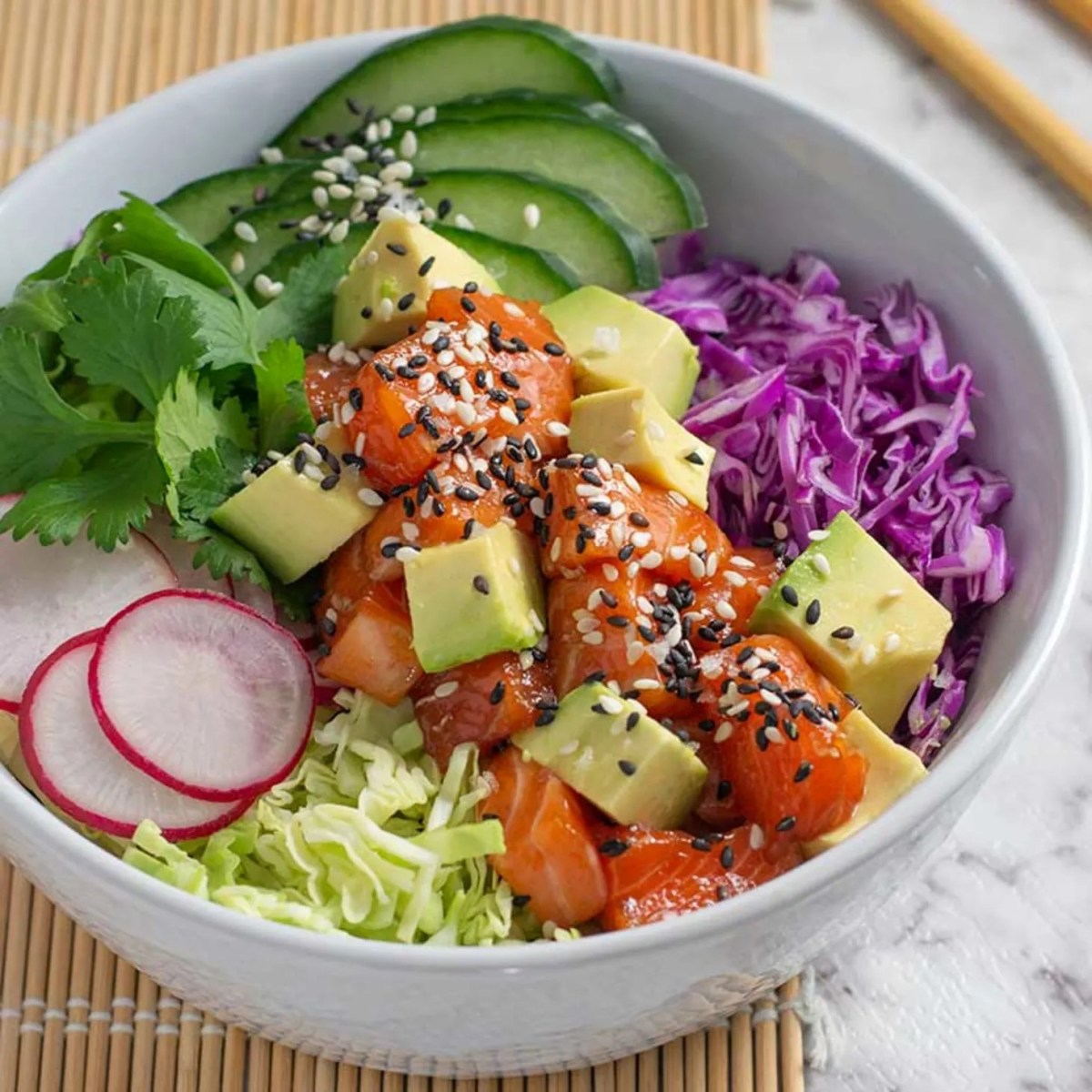Craving sushi but committed to your keto lifestyle? Imagine vibrant bowls bursting with fresh, flavorful ingredients, satisfying your cravings without derailing your diet. This isn’t about sacrificing taste; it’s about reinventing it. We’ll explore the art of crafting quick, delicious, and healthy keto sushi bowls, perfect for busy weekdays. Get ready to discover a world of flavor combinations and meal-prep strategies that will transform your lunch routine.
From succulent shrimp and savory tofu to tender chicken, we’ll unveil three unique keto sushi bowl recipes, each meticulously detailed with nutritional information and stunning visuals. Learn how to master the art of keto “rice” substitutes, explore a universe of keto-friendly sauces, and adapt recipes to accommodate dietary restrictions. We’ll even guide you through efficient meal prepping, ensuring you have a week’s worth of delicious, ready-to-go lunches.
Recipe Variations

Keto sushi bowls offer a delightful and flexible approach to enjoying the flavors of sushi without the carbs. By swapping out traditional rice for cauliflower rice or zucchini noodles, you can create a satisfying and nutritious meal perfect for a quick lunch. The following recipes showcase the versatility of this adaptable dish, highlighting different protein sources to cater to diverse tastes and dietary preferences.
Keto Sushi Bowl Recipes
Three distinct keto sushi bowl recipes are presented below, each featuring a different primary protein source: shrimp, tofu, and chicken. These variations demonstrate the adaptability of this keto-friendly meal, allowing for customization based on individual preferences and dietary needs. Each recipe provides a balanced combination of healthy fats, protein, and low-carb vegetables.
| Recipe | Protein (per serving) | Macros (per serving) (approx.) | Calories (per serving) (approx.) |
|---|---|---|---|
| Shrimp Keto Sushi Bowl | 4 oz cooked shrimp | Fat: 25g, Protein: 20g, Net Carbs: 5g | 350 |
| Tofu Keto Sushi Bowl | 4 oz pan-fried tofu | Fat: 15g, Protein: 18g, Net Carbs: 4g | 300 |
| Chicken Keto Sushi Bowl | 4 oz shredded chicken | Fat: 20g, Protein: 25g, Net Carbs: 6g | 380 |
Macro-Nutrient Infographic
Imagine a vibrant infographic, divided into three sections, one for each keto sushi bowl recipe. Each section is a circular pie chart, visually representing the macro-nutrient breakdown. The Shrimp Keto Sushi Bowl’s chart shows a large segment in a deep orange for fat (approximately 50%), a significant portion in light pink for protein (approximately 40%), and a small sliver in a pale green for net carbs (approximately 10%). The Tofu Keto Sushi Bowl chart displays a slightly smaller orange segment for fat (approximately 33%), a larger pink segment for protein (approximately 47%), and a very small pale green sliver for net carbs (approximately 10%). Finally, the Chicken Keto Sushi Bowl’s chart shows a moderately sized orange segment for fat (approximately 40%), a larger pink segment for protein (approximately 50%), and a small pale green sliver for net carbs (approximately 10%). Each section clearly labels the macronutrient and its percentage. The background of the infographic is a clean white, allowing the vibrant colors of the charts to stand out. A title, “Keto Sushi Bowl Macro Breakdown,” is prominently displayed at the top.
Preparation Time and Difficulty
The preparation time and difficulty level for each recipe are relatively similar, making them ideal for busy weekdays. The shrimp and chicken variations require slightly more cooking time due to the need to cook the protein, but the overall process remains straightforward. The tofu bowl, however, offers a slightly faster preparation time as the tofu only requires a quick pan-fry. All three recipes are considered easy to prepare, requiring basic cooking skills and readily available ingredients. The estimated preparation time for each is between 15-20 minutes.
Meal Prep & Storage Strategies
Mastering the art of meal prepping keto sushi bowls transforms your lunch routine from a daily scramble into a streamlined, healthy habit. Efficient preparation ensures you enjoy vibrant, flavourful meals all week long, minimizing time spent in the kitchen and maximizing your adherence to your ketogenic diet. Proper storage techniques are equally crucial, preserving the freshness and quality of your carefully crafted bowls.
Preparing keto sushi bowls for a week’s worth of lunches involves strategic planning and efficient execution. Think of it as an assembly line for healthy eating. Prepping components ahead of time significantly reduces the daily workload. This approach not only saves time but also guarantees consistent portion control and a balanced nutritional intake.
Efficient Meal Prepping Techniques
Prepping components in advance is key to efficient meal preparation. Imagine a vibrant scene: a neatly organized countertop displaying meticulously chopped avocado, precisely measured cauliflower rice, and perfectly seasoned tuna. This is your battle station for creating multiple keto sushi bowls with ease. Begin by cooking your protein (such as salmon, shrimp, or tofu) and preparing your vegetables (cucumber, bell peppers, spinach). Cook a large batch of cauliflower rice – this forms the base of your bowls. Prepare your sauces and dressings in advance, storing them in airtight containers. Then, assemble the bowls in individual containers, layering the ingredients carefully to maintain visual appeal and prevent sogginess.
Optimal Storage and Reheating Methods
Maintaining the freshness and quality of your keto sushi bowls is crucial. Glass containers with airtight lids are ideal for storing prepared keto sushi bowls in the refrigerator. These containers prevent the absorption of odors from other foods and help maintain the crispness of vegetables. For longer storage (up to 3 days), consider separating components such as the sauce from the main bowl. This prevents the cauliflower rice from becoming soggy. When reheating, avoid microwaving, which can lead to a mushy texture. Instead, gently warm the bowl in a pan on low heat, or enjoy it cold for a refreshing lunch. The visual appeal of the perfectly reheated bowl – with its vibrant colours and textures still intact – is a testament to your careful preparation and storage.
Creative Packaging Solutions
Transporting your keto sushi bowls requires equally thoughtful consideration. Reusable glass containers are a sustainable and aesthetically pleasing option. Their durability ensures your carefully crafted meals arrive at your destination intact. Alternatively, sturdy, leak-proof plastic containers provide a lightweight and portable solution. For added visual appeal, consider using decorative washi tape or stickers to personalize your containers. Visualize this: a collection of brightly coloured containers, each neatly labelled and decorated, ready to brighten your lunch break. These are not just containers; they are portable works of art, reflecting your commitment to healthy and visually pleasing eating.
Serving Suggestions & Flavor Combinations
Unlocking the full potential of your keto sushi bowls lies in exploring the diverse world of flavor combinations. The right blend of ingredients can transform a simple meal into a culinary adventure, satisfying both your taste buds and your dietary needs. By thoughtfully selecting sauces, toppings, and side dishes, you can create a unique and delicious experience every time.
Experimentation is key to discovering your perfect keto sushi bowl. The beauty of this dish lies in its adaptability. The base remains consistent—a bed of cauliflower rice or zucchini noodles—but the possibilities for flavor profiles are virtually limitless. Think vibrant, fresh, and exciting, and let your creativity guide you.
Five Unique Flavor Combinations for Keto Sushi Bowls
These flavor combinations showcase the versatility of keto sushi bowls, catering to a range of palates. Each profile offers a distinct culinary journey, proving that healthy eating doesn’t have to be bland.
- Spicy Tuna Delight: Imagine succulent seared tuna, generously drizzled with a spicy sriracha mayo, atop a bed of vibrant cauliflower rice. A sprinkle of sesame seeds and a few slices of avocado add texture and richness, creating a bowl bursting with flavor and a pleasant kick.
- California Dreamin’: This combination evokes the classic California roll. Use imitation crab meat (ensure it’s keto-friendly), creamy avocado slices, and a light drizzle of a soy sauce alternative (coconut aminos work well). The subtle sweetness of the avocado perfectly complements the savory crab.
- Teriyaki Salmon Sensation: Picture flaky grilled salmon, glistening with a homemade teriyaki sauce (made with coconut aminos and sweeteners like erythritol), nestled on a bed of zucchini noodles. Toasted slivered almonds add a delightful crunch, while a sprinkle of chopped green onions provides a fresh, herbaceous note.
- Mediterranean Escape: This bowl transports you to the sun-drenched shores of the Mediterranean. Use marinated grilled shrimp, crumbled feta cheese, chopped Kalamata olives, and a vibrant lemon-herb dressing. A bed of cauliflower rice completes this light, refreshing bowl.
- Korean BBQ Beef Bowl: Tender slices of marinated beef, cooked in a rich and savory keto-friendly Korean BBQ sauce (made with coconut aminos and gochujang), are served atop a bed of cauliflower rice. Kimchi (ensure it’s low-carb) adds a spicy, fermented kick, while sesame seeds add a nutty aroma and texture.
Comparison of Keto-Friendly Sauces and Toppings
Choosing the right sauce and toppings significantly impacts the overall flavor profile of your keto sushi bowl. This table highlights the characteristics of popular options, allowing for informed selection based on desired taste.
| Sauce/Topping | Flavor Profile | Texture | Nutritional Considerations |
|---|---|---|---|
| Sriracha Mayo | Spicy, creamy, savory | Smooth, creamy | High in healthy fats, moderate in calories |
| Coconut Aminos | Savory, umami, slightly sweet | Liquid | Low in carbs, gluten-free |
| Homemade Teriyaki (Coconut Aminos based) | Sweet, savory, umami | Syrupy | Low carb, high in sodium |
| Lemon-Herb Dressing (Olive Oil based) | Bright, citrusy, herbaceous | Liquid | High in healthy fats, low in carbs |
Recommended Side Dishes for Keto Sushi Bowls
Completing your keto sushi bowl experience requires thoughtful consideration of side dishes. These additions enhance the meal’s overall appeal and nutritional value, providing a balanced and satisfying culinary experience.
- Seaweed Salad: A refreshing and low-carb addition, providing a salty and umami counterpoint to the bowl.
- Shirataki Noodles: A low-carb noodle alternative that can add a different textural element to the meal.
- Edamame (in moderation): A small serving of edamame offers a healthy dose of protein and fiber.
- Avocado Salad: A simple salad with diced avocado, cherry tomatoes, and a light vinaigrette provides a healthy and refreshing side.
- Pickled Ginger: A small amount of pickled ginger adds a sharp, tangy flavor contrast.
With a little creativity and the right ingredients, keto sushi bowls become a vibrant and versatile addition to your healthy eating plan. We’ve journeyed through recipe variations, ingredient substitutions, and efficient meal-prep strategies, equipping you to craft delicious and satisfying lunches that fit seamlessly into your keto lifestyle. Embrace the freedom of customizable flavors, and say goodbye to lunchtime boredom. The possibilities are endless, so start experimenting and enjoy the delicious results!
FAQ Insights
Can I use cauliflower rice in place of all the suggested rice alternatives?
While cauliflower rice is a popular keto option, it can sometimes become mushy when used in sushi bowls. Consider alternatives like shirataki noodles or finely shredded daikon radish for better texture.
Are there any specific types of seaweed sheets that are better for keto?
Most seaweed sheets are naturally low-carb and keto-friendly. Look for options that are minimally processed and free of added sugars.
How long can I store prepared keto sushi bowls in the refrigerator?
Properly stored in airtight containers, keto sushi bowls generally last for 3-4 days in the refrigerator. However, it’s best to consume them within 2 days for optimal freshness.
What are some good alternatives to soy sauce for those with soy allergies?
Coconut aminos or tamari (wheat-free soy sauce) are excellent soy sauce alternatives. You can also experiment with low-sodium fish sauce or a combination of rice vinegar and sesame oil.


